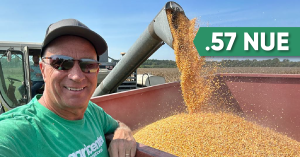Last week I was a guest on the TopSoil Webinar series hosted by Mitchell Hora of Continuum Ag (you can check it out here). I mentioned how western growers seem further along in their regenerative agriculture journey. That’s largely driven by regional attitudes and the food companies, who have pledged to sell products grown using regen ag practices. This has motivated growers of crops such as potatoes, onions, apples, and blueberries to hasten their adoption. But in the Heartland, where commodity crops fill the landscape, these growers have lacked many of the market-driven economic incentives. Until now.
As part of 2022’s Inflation Reduction Act, biofuel makers will be rewarded with Section 45Z tax benefits for sourcing sustainably sourced crops. Biofuel plants are a common destination for Midwestern, as well as Southern, grain. Over 35% of corn grown in the USA is used to produce ethanol. In Iowa, that number is 51%. It’s 46% in Tennessee. While details are still being ironed out, farmers appear destined to share in the pool of money created by the tax benefits awarded to biofuel makers. Better still, the more sustainably you grow your crop, the greater the financial awards. A Carbon Intensity (CI) Score – the amount of carbon used to produce a unit of grain – will be assigned to each bushel of grain, based on the farming practices used to produce that bushel. The goal is to achieve a score below the national average, which for corn is 29.1. Cultural practices such as cover crops and no-till will significantly reduce CI scores. But so will reductions in fertilizer, including nitrogen use efficiency. That’s where Huma products play a key role. Due to our proprietary Micro Carbon Technology, many Huma nutrients can be applied at rates significantly lower than grower standards, thus reducing fertilizer usage and significantly lowering CI scores. As I said on the webinar, we consider CI score incentives a major “bonus” for growers, as Huma products provide many direct soil health, cost saving, plant health and yield benefits. But there’s no denying that this new revenue stream will draw lots of attention and interest for our humic solutions. It’s our mission to help drive the movement.
As I told some farmer friends last week, that spring federal crop insurance price (set at $5.91 per bushel for corn) sure looks good about now. Judging by its name, you might think of crop insurance simply as protection against unforeseen events. Like when the roof of your house gets struck by hail, or when you get into a fender bender and your car needs repaired. But the benefits of FCI extends well beyond weather events that reduce yield. It’s even possible to produce record crop yields and still collect a payout. How can that be, you say? FCI also protects growers against price fluctuations, making it a critical risk management tool that, if managed properly, can become an income generator. This year is a perfect example. Say your farm has an average production history (APH) of 200 bu/A. And you elected to take out the maximum coverage level of 85%. That means you are guaranteed to earn $1,004.70 per acre (170 bu/A x $5.91). At harvest you made a record corn yield of 210 bu/A. Now you might think, after paying a steep premium price of $32/A, that FCI was a waste. But not so fast. Corn prices have taken a dive this year, hitting $4.26 in west Tennessee last week. At this price, your best-ever yield of 210 bu/A earned a gross profit of $896.60. Even after subtracting the premium, you still net $76.10 more per acre from the policy. FCI payments will be kicking in for many farmers this season, between lower yields due to drought and lower commodity prices. This is why commodity groups fight so hard to keep FCI as part of the Farm Bill. It’s the largest line item geared toward farmers. The federal government subsidizes FCI, paying 60% of the premiums. This is a heavy incentive for farmers to purchase it. Many could not justify the expense otherwise.
The reality of crop insurance kicking in is indicative of a weakening farmer sentiment, which has dipped 9 points over last month according to the monthly Purdue Ag Economy Barometer. Higher crop inputs (which has dropped from 34% to 32%) and rising interest rates (25%) are joined by lower crop prices (22%, up from 20% last month) as the leading concerns.
It’s #NationalCooperativeMonth. Coops form the backbone of the ag industry. Nearly 1,700 agricultural coops across the fruited plain serve their members with financing, crop inputs, fuel, propane, grain elevators, precision farming services, custom application, electricity, biofuel markets and more. What makes a cooperative unique is that customers are also the owners. In some cases, they receive annual patronage dividends based on the success of the association. Coops are governed by local, farmer-elected boards. Nearly 40% of crop inputs in the USA are sold through cooperatives. Ag retail cooperatives who sell crop inputs represent a significant market opportunity for Huma. Throughout my career, I have enjoyed working for many cooperatives, including several Farm Credit associations (the nation’s largest ag lenders) and Growmark (the nation’s fourth largest ag retailer). I’ve also patronized some as a member-owner farmer. They all seem to have a lot in common. Much of the heavy lifting is done at branch locations in local markets. The successful coops tend to have very strong and dynamic CEOs that set policy. That does not mean they are difficult to work with (from my experience, it’s quite the opposite) it just seems to be how they are run. In my extensive dealings with Farm Credit, they have a wonderful culture. I’ve found Farm Credit people to be among the nicest people in the world, from the executives to the field level. I’d rank Farm Credit very similar to Huma in that regard.
NIL deals are now the rave of college sports. Athletes are being rewarded for bearing their name, image and likeness to marketing endeavors. There’s a famous set of women’s basketball playing twins from Huma’s hometown of Gilbert, Arizona, that earned over $2 million in 2022 on NIL deals and command $75,000-100,000 per endorsement as social media influencers. While that’s among the top end of NIL deals, one of the more creative comes from the union between Iowa Pork Producers and Iowa State University. It’s only natural that Myles Purchase, Tyler Moore, Tommy Hamman and Caleb Bacon would play together in the nation’s #1 pork producing state. For lending their likeness, Iowa Pork is donating $1,000 worth of the other white meat to the food pantries of each player’s choosing. That’s definitely a Win-Win-Win.
On Thursday we celebrate the 1.5% of Americans everyone depends on three times a day, every day. The world’s greatest profession. #NationalFarmersDay.
Global Fertilizer Day is Friday. This is when we commemorate one of the most significant inventions in modern history, the Haber-Bosch process, credited for feeding about half of the world’s population. In 1908, German chemist Fritz Haber patented the process of synthesizing nitrogen-rich ammonia from the air. The process was scaled up by BASF chemist Carl Bosch, leading to the famous Haber-Bosch process, which synthesizes nitrogen-rich ammonia from the air. This breakthrough invention made nitrogen production economically feasible on a mass scale. The basics of the process is still used today. The end product, anhydrous ammonia, contains 82% nitrogen, making it the most economical source of nitrogen. Fertilizer has evolved significantly since that landmark discovery over a century ago. Today, fertilizer is a $212 billion global business. And companies like Huma are making it more sustainable, by dramatically lowering fertilizer inputs while raising crop outputs.
Related Posts

Wastewater Wednesday: Swansea in Massachusetts Uses Federal Funding for Sewer Expansion

This Week in Ag #66
When asked if he was finished with planting, dad would frequently respond by saying, “the first time.” His cynicism aside, replant decisions can be difficult. This year, too many growers are faced with that decision. If you plant when the soil is cold and wet, you’re inviting problems. But even if you plant in good soil conditions,...

This Week in Ag #47
Nitrogen Use Efficiency has quickly become part of the vocabulary surrounding sustainability. But NUE is more than just a buzzword or another fancy acronym. NUE is the benchmark for nitrogen management. You’ll often see it used to measure the amount of nitrogen used to produce a bushel of grain. NUE is a pillar for calculating...



